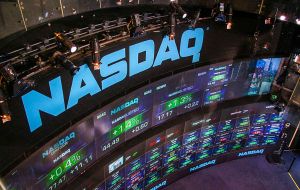MercoPress. South Atlantic News Agency
Volatile session in US markets with indexes continuing the several sessions slide
 In its sixth consecutive day of declines, the S&P closed down 2.1% after shedding 3% in Wednesday’s session
In its sixth consecutive day of declines, the S&P closed down 2.1% after shedding 3% in Wednesday’s session  Nasdaq during the session fell as much as 10.3% from its Aug. 29 closing record high but ended the day 9.6% below the record
Nasdaq during the session fell as much as 10.3% from its Aug. 29 closing record high but ended the day 9.6% below the record Wall Street indexes continued their slide in Thursday’s volatile session as investors worried about rising interest rates and braced for a trade war hit to corporate earnings a day ahead of the quarterly reporting season kickoff.
In its sixth consecutive day of declines, the S&P closed down 2.1% after shedding 3% in Wednesday’s session. But at its session low the benchmark fell 2.7% to its lowest level since early July.
Nasdaq narrowly avoided confirming a correction. During the session it fell as much as 10.3% from its Aug. 29 closing record high but ended the day 9.6% below the record.
Investors worried that equity markets would have trouble recovering as rising interest rates coincide with uncertainty about how much earnings growth would be hurt by a U.S. trade war with China.
The Dow Jones Industrial Average fell 545.91 points, or 2.13%, to 25,052.83, the S&P 500 lost 57.31 points, or 2.06%, to 2,728.37 and the Nasdaq Composite dropped 92.99 points, or 1.25%, to 7,329.06.
After hitting an intraday high of 28.84, the CBOE Volatility Index, popularly known as the “fear gauge,” ended the day up 2 points at 24.98, its highest close since Feb. 12.
The energy sector, pressured by a drop in oil prices, was the lead decliner, while insurers were some of the biggest losers in the financial sector a day after powerful Hurricane Michael slammed into Florida.
The financial sector fell 2.9%, also hurt by a 2.7% drop in bank stocks a day before three of the biggest banks were to report quarterly results. Wall Street expects S&P 500 companies to report third-quarter earnings growth of 21.3% for the third quarter according to I/B/E/S data from Refinitiv.
The technology sector, the biggest loser in Wednesday’s sell-off, closed down 1.3 percent on Thursday.
Stocks had seen some support earlier in the session from U.S. data showing a smaller-than-anticipated rise in consumer prices as it helped ease fears of increasing inflation pressures.
The data helped push U.S. Treasury yields to a one-week low, further soothing equity investors.
But investors still faced a sea of worries, including uncertainty ahead of U.S. midterm congressional elections on Nov. 6, and hawkish comments last week from U.S. Federal Reserve officials.
Declining issues outnumbered advancing ones on the NYSE by a 3.52-to-1 ratio; on Nasdaq, a 2.66-to-1 ratio favored decliners. The S&P 500 posted no new 52-week highs and 62 new lows; the Nasdaq Composite recorded 6 new highs and 291 new lows.
Volume on U.S. exchanges was 11.44 billion shares, its highest level since Feb. and compared with the 7.65 billion-share average for the full session over the last 20 trading days.
Oil prices slumped to two-week lows as global stock markets fell, with investor sentiment made more bearish by an industry report showing U.S. crude inventories rising more than expected.
Brent crude LCOc1 futures fell US$ 2.83 to settle at US$ 80.26 a barrel, while U.S. West Texas Intermediate (WTI) crude CLc1 futures fell US$ 2.20 to settle at US$ 70.97 a barrel.




Top Comments
Disclaimer & comment rulesCommenting for this story is now closed.
If you have a Facebook account, become a fan and comment on our Facebook Page!